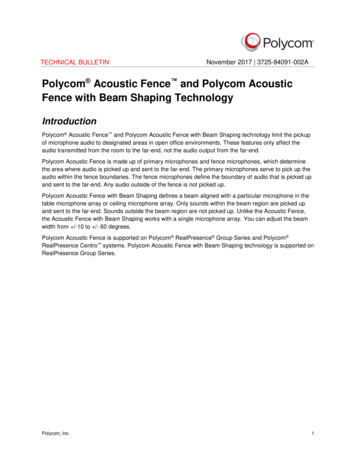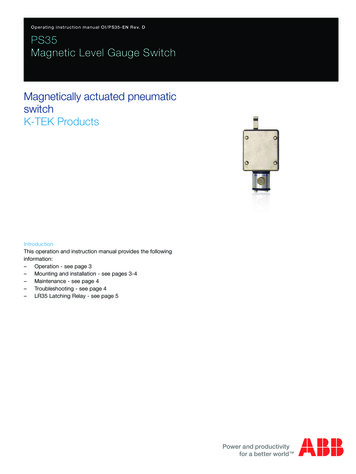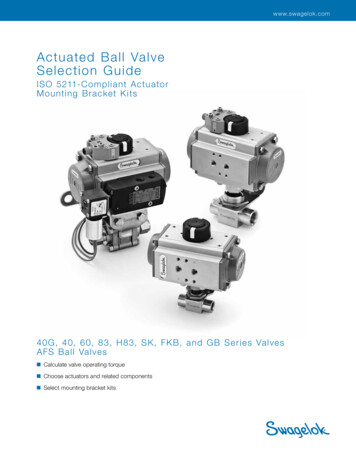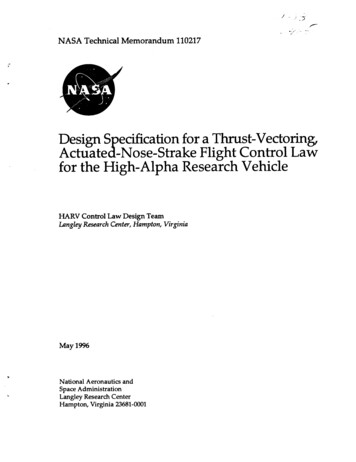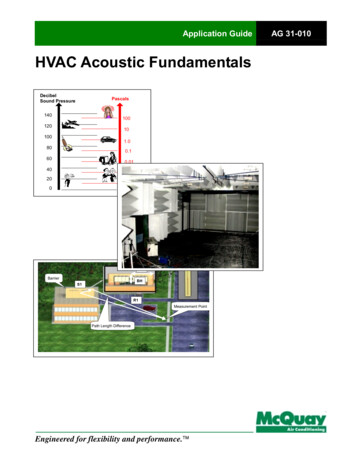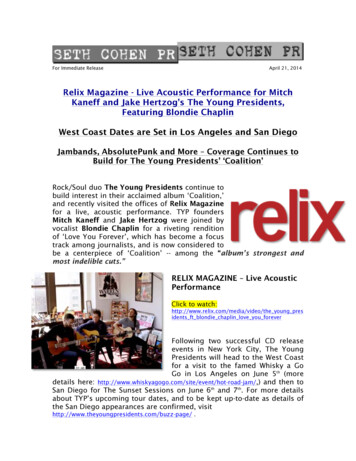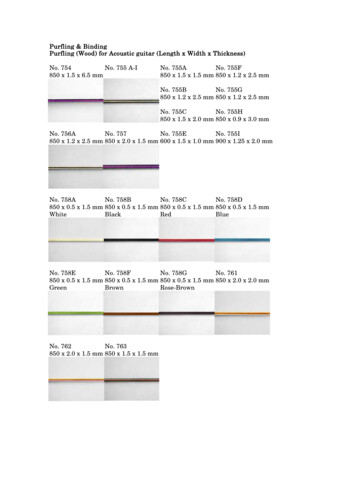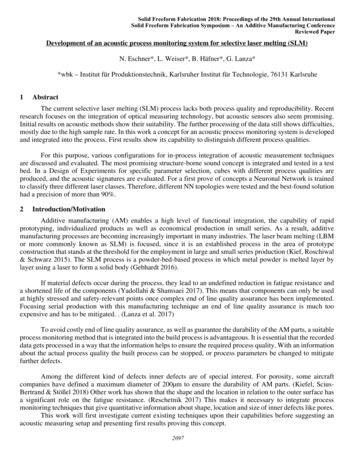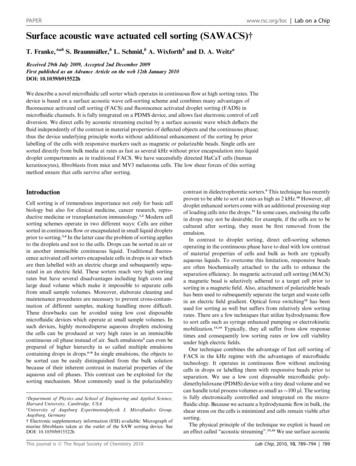
Transcription
PAPERwww.rsc.org/loc Lab on a ChipSurface acoustic wave actuated cell sorting (SAWACS)†T. Franke,*ab S. Braunm uller,b L. Schmid,b A. Wixforthb and D. A. WeitzaReceived 29th July 2009, Accepted 2nd December 2009First published as an Advance Article on the web 12th January 2010DOI: 10.1039/b915522hWe describe a novel microfluidic cell sorter which operates in continuous flow at high sorting rates. Thedevice is based on a surface acoustic wave cell-sorting scheme and combines many advantages offluorescence activated cell sorting (FACS) and fluorescence activated droplet sorting (FADS) inmicrofluidic channels. It is fully integrated on a PDMS device, and allows fast electronic control of celldiversion. We direct cells by acoustic streaming excited by a surface acoustic wave which deflects thefluid independently of the contrast in material properties of deflected objects and the continuous phase;thus the device underlying principle works without additional enhancement of the sorting by priorlabelling of the cells with responsive markers such as magnetic or polarizable beads. Single cells aresorted directly from bulk media at rates as fast as several kHz without prior encapsulation into liquiddroplet compartments as in traditional FACS. We have successfully directed HaCaT cells (humankeratinocytes), fibroblasts from mice and MV3 melanoma cells. The low shear forces of this sortingmethod ensure that cells survive after sorting.IntroductionCell sorting is of tremendous importance not only for basic cellbiology but also for clinical medicine, cancer research, reproductive medicine or transplantation immunology.1,2 Modern cellsorting schemes operate in two different ways: Cells are eithersorted in continuous flow or encapsulated in small liquid dropletsprior to sorting.3,4 In the latter case the problem of sorting appliesto the droplets and not to the cells. Drops can be sorted in air orin another immiscible continuous liquid. Traditional fluorescence activated cell sorters encapsulate cells in drops in air whichare then labelled with an electric charge and subsequently separated in an electric field. These sorters reach very high sortingrates but have several disadvantages including high costs andlarge dead volume which make it impossible to separate cellsfrom small sample volumes. Moreover, elaborate cleaning andmaintenance procedures are necessary to prevent cross-contamination of different samples, making handling more difficult.These drawbacks can be avoided using low cost disposablemicrofluidic devices which operate at small sample volumes. Insuch devices, highly monodisperse aqueous droplets enclosingthe cells can be produced at very high rates in an immisciblecontinuous oil phase instead of air. Such emulsions5 can even beprepared of higher hierarchy in so called multiple emulsionscontaining drops in drops.6–8 In single emulsions, the objects tobe sorted can be easily distinguished from the bulk solutionbecause of their inherent contrast in material properties of theaqueous and oil phases. This contrast can be exploited for thesorting mechanism. Most commonly used is the polarizabilityaDepartment of Physics and School of Engineering and Applied Science,Harvard University, Cambridge, USAbUniversity of Augsburg Experimentalphysik I, Microfluidics Group,Augsburg, Germany† Electronic supplementary information (ESI) available: Micrograph ofmurine fibroblasts taken at the outlet of the SAW sorting device. SeeDOI: 10.1039/b915522hThis journal is ª The Royal Society of Chemistry 2010contrast in dielectrophoretic sorters.9 This technique has recentlyproven to be able to sort at rates as high as 2 kHz.10 However, alldroplet enhanced sorters come with an additional processing stepof loading cells into the drops.11 In some cases, enclosing the cellsin drops may not be desirable; for example, if the cells are to becultured after sorting, they must be first removed from theemulsion.In contrast to droplet sorting, direct cell-sorting schemesoperating in the continuous phase have to deal with low contrastof material properties of cells and bulk as both are typicallyaqueous liquids. To overcome this limitation, responsive beadsare often biochemically attached to the cells to enhance theseparation efficiency. In magnetic activated cell sorting (MACS)a magnetic bead is selectively adhered to a target cell prior tosorting in a magnetic field. Also, attachment of polarizable beadshas been used to subsequently separate the target and waste cellsin an electric field gradient. Optical force switching12 has beenused for sorting as well but suffers from relatively slow sortingrates. There are a few techniques that utilize hydrodynamic flowto sort cells such as syringe enhanced pumping or electrokineticmobilization.13,14 Typically, they all suffer from slow responsetimes and consequently low sorting rates or low cell viabilityunder high electric fields.Our technique combines the advantage of fast cell sorting ofFACS in the kHz regime with the advantages of microfluidictechnology. It operates in continuous flow without enclosingcells in drops or labelling them with responsive beads prior toseparation. We use a low cost disposable microfluidic polydimethylsiloxane (PDMS) device with a tiny dead volume and wecan handle total process volumes as small as 100 ml. The sortingis fully electronically controlled and integrated on the microfluidic chip. Because we actuate a hydrodynamic flow in bulk, theshear stress on the cells is minimized and cells remain viable aftersorting.The physical principle of the technique we exploit is based onan effect called ‘‘acoustic streaming’’.15,16 We use surface acousticLab Chip, 2010, 10, 789–794 789
waves (SAW) to drive microflows in the PDMS channels. As longas the SAW propagates on the surface of the substrate it is barelydamped. However, when the substrate is covered with water thewave irradiates energy into the liquid which gives rise to internalstreaming of the fluid. The effect has been utilized to actuatedrops on open surfaces17 and in closed channels18 and to enhancemixing.19,20 This streaming effect differs significantly fromanother commonly used technique which employs standingsurface acoustic waves21 (SSAW) which can be used to align andwash particles.22–24 However, the underlying physical principle iscompletely different: In SSAW, a stationary standing wave isbuilt up and objects are driven to positions of larger or smallerwave amplitude according to their compressibility contrast withrespect to the suspending medium.25 This force is often termed asacoustic radiation force and is induced by an ultrasonic standingwave field.26–28 Acoustic radiation force acting on an interfacebetween two liquids with different densities can also be used toactuate the heterogeneous fluid itself.28 By contrast, in our devicewe actuate the homogeneous continuous fluid including theobjects and no contrast in compressibility, dielectric constant ordensity is required.18Experimental setupSAW – PDMS hybrid deviceThe hybrid sorting device we present in this article directs cells byacoustic streaming induced by a surface acoustic wave ona piezoelectric substrate. We excite the surface acoustic wave byan interdigitated transducer (IDT). The IDT consists of two goldelectrodes deposited onto the piezoelectric substrate, each witha comb-like interdigitated-finger structure. The operatingfrequency of the IDT is determined by the ratio of the soundvelocity in the substrate to twice the finger spacing. The IDT hasa tapered shape with a decreasing finger repeat distance varyingfrom 23 to 28 mm. This provides a particularly narrow wave pathwidth for the sound wave propagating on the substrate becausethe finger spacing only obeys the resonance condition at oneposition. The frequency was varied between 140 MHz and150 MHz, which corresponds to a finger spacing of 25.4 mm to27.3 mm. The gold electrodes are produced by vapour depositionand standard lithography. The anisotropic piezoelectricsubstrate is a Y-cut LiNbO3 with the crystal axis rotated aroundthe X-axis by 128 (128 Y-Cut). The fingers of the IDT arecarefully aligned perpendicular to the X-axis and the alternatingRF frequency therefore excites a Rayleigh wave propagating inthe direction of the X-axis. To apply the high frequency voltagewe use a GHz-signal generator (Wavetek, Model 3010) andsubsequently amplify the signal to a power of 30 dBm. Toassemble the microfluidic hybrid device, both the PDMS mouldand the piezo-substrate were treated in ozone plasma and carefully assembled on top of each other under a microscope. Theenclosed PDMS channel with a height of 50 mm and three inlets isfabricated using soft lithography. The fluid in the main channel,which contains the cells, is hydro-dynamically focussed by thefluid from the two side inlets to align the cells horizontally, andcells are subsequently sorted in one of the two outlet channels.The IDT is positioned directly beside the channel and cells flowinto the collect or waste channel depending on the actuation state790 Lab Chip, 2010, 10, 789–794Fig. 1 Schematic illustrations and corresponding phase contrastmicrographs of the surface-acoustic-wave-actuated PDMS hybrid chipfor cell sorting (top views): The main channel is hydrodynamicallyfocused by adjusting the flows through two side channels. Withoutapplying a surface acoustic wave the jet of the main channel movesinto the left outlet channel due to its lower hydrodynamic resistance.Schematic illustration and phase contrast micrograph (OFF, left). Whenswitching on the SAW, acoustic streaming is induced and deflects thefocussing stream into the right channel outlet (ON, right). Because cellsare only in the focused region of the flow they can be directed into thedesignated channel. The dark blue and the light grey region in theschematic illustration and the micrograph respectively are the areas ofcontact of PDMS mould and piezo-substrate.of the IDT as shown in Fig. 1. The bonded PDMS–SAW hybriddevice is mounted on the stage of an inverted fluorescencemicroscope and imaged by a fast camera (Photron, Fastcam1024 PCI).Cell sample preparationWe demonstrate the usefulness of the device for cell sorting withthree different cell types: HaCaT cells (humane keratinocytes,Biochrom AG, Berlin), murine fibroblasts L929 cells (obtainedfrom S. Thalhammer, Munich) and MV3 melanoma cells(obtained from S. Schneider, M unster). The HaCaT cells andthe murine fibroblasts were maintained in RPMI medium(Biochrom AG), the MV3-cells in MEM medium (PAA). Allmedia were supplemented with 10% fetal bovine serum (PAA)and 1% streptavidin/penicillin. Confluent cells were harvestedwith Trypsin/EDTA. For sorting experiments, cells wereThis journal is ª The Royal Society of Chemistry 2010
resuspended in a 0.85% (w/v) NaCl solution, buffered with Hepes(30 mM) containing 1% (w/v) BSA and 14% OptiPrep (SigmaAldrich) density gradient medium to increase buoyancy fordensity matching. The sheath buffer was PBS (pH 7.4) only.Operating principleThe SAW deflects the flow only in a small region between yONand yOFF as highlighted in blue in Fig. 2. The action of thesurface acoustic wave input on the acoustic streaming is instantaneous on a ms-time scale, but because the blue region of SAWcoupling and the sorting junction at the origin of the x–y coordinate system in Fig. 2 do not coincide its effect on sorting isdelayed by the time that it takes for the deflected fluid flow toreach the sorting junction.To illustrate the sorting principle and correlate the input signal(power on/off) of the SAW to the output signal, which is thedeflection of the focussed jet, we consider a square wave input asshown in Fig. 2. The period T of the square wave is given by thesquare wave modulation frequency fIDT of the interdigitaltransducer T ¼ 1/fIDT and determines the sorting rate. In theexperiment we have varied this frequency fIDT between 100 Hzand 2 kHz.Such a signal causes a x-deflection at position y ¼ 0 as shownin the right schematic plot: the onset of SAW pulse is at timet ¼ 0, and has no immediate x-deflection, x ¼ xmin (jet flows in leftoutlet channel). Instead, the action of the SAW causes deflectionat this position only after a delay of tdelay ¼ yoff/vflow, with flowvelocity vflow, because the diversion in the flow has to traveldownstream. This is followed by a linear increase in deflection upto the maximum at t ¼ yon/vflow. At that time a particle withinitial position y ¼ yon at t ¼ 0 passes the branch at y ¼ 0. Thismaximal deflection x ¼ xmax lasts until the SAW power isswitched off again at t ¼ T/2, whereupon the flow follows thereverse characteristics of the deflection profile. The maximumand minimum deflections can be controlled by the flow of sidechannels and the SAW power, while the flow velocity vflow can beadjusted by the inlet flow rates.Fig. 2 Micrograph of a deflected hydrodynamically focussed jet (leftimage) and schematic of the time dependence of jet deflection in themicrochannel caused by switching a square wave ‘‘ON’’ and ‘‘OFF’’ (rightimage). The blue square wave is the input signal (square wave modulationof SAW) and the green line corresponds to the output signal (fluid jetdeflection). The origin of the x–y coordinate is set to be at the branch ofthe waste and collect channels. The y-direction is the flow direction of theliquid flow and the x-direction is the direction of deflection due to anapplied SAW. Shaded in blue is the region where the SAW is acting on thejet (left image).This journal is ª The Royal Society of Chemistry 2010ResultsPeriodically alternating the amplitude of the surface acousticwave causes the focussed jet to deflect with the same frequency asthe modulation frequency of the exciting SAW. A cell movingfrom the main channel is aligned within this jet and follows theflow downstream as shown in Fig. 3. We carefully adjust theposition of the jet prior to the sorting experiment by controllingthe pressure of the sheath flows with the SAW off. This procedure is critical to the sorting ratio of cells in the left andright channel for periodically oscillating excitation. Forinstance, if one intends a 1 : 1 sorting in both outlets, necessarilyxmin ¼ xmax (see also Fig. 2).We evaluate the sorting efficiency by the number of cells sortedinto the collect and waste channel respectively. We apply a periodically oscillating square wave signal depending on time to theIDT and vary its frequency fIDT from 100 Hz to 2 kHz. Here, onewould expect cells to be periodically sorted into the collectchannel when the SAW is switched on and into the waste channelwhen the SAW is switched off. We characterize the time dependence by the phase angle. The phase angle is the time since thelast switch off of the SAW divided by the period T. For eachfrequency we count the number of cells falling into one of thechannels as a function of the corresponding phase angle 4. Wefind experimentally that for one phase angle interval all cells aredirected in the collect channel while for another interval all cellsenter the waste channel without exception (100% sorting efficiency). We denote the length of these intervals by 4collect and4waste, respectively. In between 4collect and 4waste are intervalswhere cells enter both the collect and waste channel at the samephase angle. We define these transient intervals where sorting isambiguous by 4ON-OFF and 4OFF-ON. We have found that thelength of these transient intervals increases with sortingfrequency while the lengths of 4collect and 4waste decrease. Ata critical sorting frequency the transient intervals expand overthe complete phase angle range (sorting efficiency 100%). Atypical experiment at 1 kHz oscillation frequency is shown inFig. 4 together with a complete list summarising all the experiments with different cell types and frequencies. Hence, an integrated cell sorter with an automated detector should be operatedbelow the critical frequency. The width of the transient intervalsalso yields an estimation of the critical sorting frequency:The width of the transient interval in Fig. 4 is 3/12f thus weestimate a critical frequency of 4 kHz. At this frequency thetransient interval is expected to expand over all phase angles.We have achieved a sorting rate of 2 kHz experimentally with100% efficiency.We demonstrate the inherent gentleness of our method witha cell viability test. From a stock solution of the fluorophoreCalcein AM in dimethyl sulfoxide (DMSO, 5 mg/ml) we added2 ml to 1 ml cell suspension. Calcein AM is retained in cellsthat have intact membranes and gives rise to a fluorescentsignal; however, it does not label dead cells, and is rapidlylost under conditions that cause cell lysis.29,30 This propertyallows us to evaluate the viability of cells which have passedthrough the SAW sorting device (see ESI†). Among the cellswhich have passed the sorting device we detect 93% viable cells ascompared to 97% viability of reference sample of murine fibroblasts which have not passed through the device. For the HaCatLab Chip, 2010, 10, 789–794 791
Fig. 3 Cell sorting in two outlets upon application of a periodically oscillating SAW amplitude. (Upper row) A cell entering the sorting regionmoves through the left channel if the SAW is switched off (default channel). (Middle row) After application of an electrical voltage to the IDT theexcited SAW bends the jet and diverts the cells into the right collect channel. The micrographs are taken at time intervals of 2 ms. (Lower row)Micrograph of MV3 cells sorted at 1 kHz. Cells entering the flow focussed area of the device from the top, in very close proximity, with three cellsin contact. However, they get separated as the flow field of the hydrodynamic cell focussed region is accelerated, and successively move throughdifferent outlet channels. The distance attained between the cells is sufficient to alternately sort them at high frequency into the right and left outlet.792 Lab Chip, 2010, 10, 789–794This journal is ª The Royal Society of Chemistry 2010
Fig. 4 (Upper histogram) Sorting efficiency of the acoustic sorter operating at 2 kHz sorting frequency (2 times oscillation frequency) is shown in a cellcount histogram. Counts were summarized over a small interval (1/12fIDT) and displayed by bars. Cells deflected in the collect channel (green) and thedefault channel (red, waste) when the SAW is applied are shown. Note that for phases within the intervals denoted as 4collect and 4waste all collected cellsenter the respective channel without exception (100% efficiency). Only at the small transient regions close to 4 ¼ 0 and 4 ¼ 0.65 do we find cells withinboth channels. The width of the intervals 4collect and 4waste differ because the cell-transporting jet is not optimally adjusted for xmin ¼ xmax (see alsodiscussion Fig. 3). (Lower table) Sorting efficiency dependence on sorting rate for different cell types. For lower frequencies sorting efficiency was 100%and all cells within the respective phase interval 4collect and 4waste were collected in the waste or collect channel. At high frequencies sorting was imperfect(lower than 100%) and no intervals 4collect and 4waste for perfect sorting could be defined. Here, we divide the phase range into only two intervals 4collectand 4waste and neglect the transient intervals 4ON-OFF and 4OFF-ON (values are in brackets in the table). We define the collect and waste efficiency by theratio of correctly sorted cells to the total number of cells falling into the corresponding interval. The highest 100%-efficient sorting rate was found forfibroblasts to be 2 kHz.cells 94% of the cells passing the sorter were viable as comparedto a control reference of 97% viability. This confirms the lowshear forces on the cells due to the flow induced by the SAWdevice.ConclusionIn summary, we demonstrate a novel sorting scheme operatingat high sorting rates of several kHz and demonstrate sortingof diverse t
In magnetic activated cell sorting (MACS) a magnetic bead is selectively adhered to a target cell prior to sorting in a magnetic field. Also, attachment of polarizable beads has been used to subsequently separate
